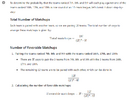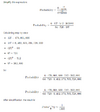1/7 = .142857142857142857142857.................... The same six digits repeating.
2/7 = .285714285714285714......................... The same six digits repeating and in the same order as 1/7, just starting from a different place.
3/7 = .428571428571..........ditto.
4/7 = .571428.........
5/7 = .714285........
6/7= .857142.................. the same six digits repeating and in the same order as 1/7, just starting from a different place.
The inverse of all prime numbers all show similar patterns (except for 2 and 5).
The number of repeating digits is one less than the number being inverted - example 1/7 is 6 recurring digits, 1/17 is 16 recurring digits etc
EXCEPT
sometimes there are two more patterns of recurring digits in the inverses. For example:
1/13 = .076923 - six recurring digits.
2/13 = .153846 recurring - a different set of 6 recurring digits.
1/13, 3/13, 4/13, 9/13, 10/13 and 12/13 all use the .076923 recurring pattern - the other fractions use the other pattern.
so - Inverse of 13 uses 2 different patterns of 6 digits - 2x6 = 12 (one less than the number being inverted).
Inverse of 3 uses 2 different patterns of 1 digit - 2x1 = 2.
Inverse of 11 uses 5 different patterns of 2 digits - 5x2 = 10.
Inverse of 37 uses 12 different patterns of 3 digits - 3x12 = 36.
Inverse of 41 uses 8 different patterns of 5 digits - 8x5 = 40.
Inverse of 53 uses 4 different patterns of 13 digits - 4x13 = 52.
Etc.....
It is apparently all explainable and fairly trivial, but it blows my mind.
2/7 = .285714285714285714......................... The same six digits repeating and in the same order as 1/7, just starting from a different place.
3/7 = .428571428571..........ditto.
4/7 = .571428.........
5/7 = .714285........
6/7= .857142.................. the same six digits repeating and in the same order as 1/7, just starting from a different place.
The inverse of all prime numbers all show similar patterns (except for 2 and 5).
The number of repeating digits is one less than the number being inverted - example 1/7 is 6 recurring digits, 1/17 is 16 recurring digits etc
EXCEPT
sometimes there are two more patterns of recurring digits in the inverses. For example:
1/13 = .076923 - six recurring digits.
2/13 = .153846 recurring - a different set of 6 recurring digits.
1/13, 3/13, 4/13, 9/13, 10/13 and 12/13 all use the .076923 recurring pattern - the other fractions use the other pattern.
so - Inverse of 13 uses 2 different patterns of 6 digits - 2x6 = 12 (one less than the number being inverted).
Inverse of 3 uses 2 different patterns of 1 digit - 2x1 = 2.
Inverse of 11 uses 5 different patterns of 2 digits - 5x2 = 10.
Inverse of 37 uses 12 different patterns of 3 digits - 3x12 = 36.
Inverse of 41 uses 8 different patterns of 5 digits - 8x5 = 40.
Inverse of 53 uses 4 different patterns of 13 digits - 4x13 = 52.
Etc.....
It is apparently all explainable and fairly trivial, but it blows my mind.

